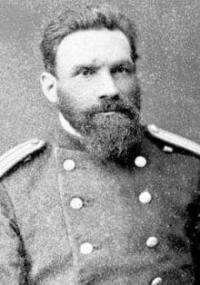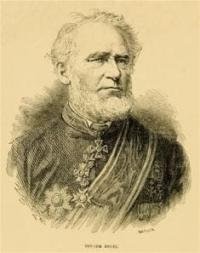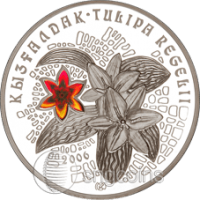You are here
Naturalist Albert Regel.




Educational tours around cities of Kazakhstan.
“Verny is built correctly, with completely European houses, in front of which there are peaches and apple trees. The city is decorated everywhere with various tree plantations of silver and black poplars, hawthorn and other trees.”
A.L. Regel. September 6, 1876.
Natural attractions of Kazakhstan.
He discovered over 26 species of rare plants, incl. nine tulips. Regel not only collected, but upon arrival home, together with his father, biologist E.L. Regel, systematized the species and genera, described them in the book “Acta horti Petropolitani”.
Grateful descendants, in memory of him, named many of the plants, completely new ones, previously unknown to science, with one short phrase in Latin “Albertia Rgl”. Well-known in science, Albert von Regel often signed himself briefly - Jean Regel. His expeditions to Highland Asia became a standard for the study of nature.
Naturalist A.E. Regel was born in Zurich on November 30, 1845. He was the eldest son of a large Swiss family of the scientist-horticulturist Eduard-August Ludwigovich Regel (1815-1892) and his wife Reguli-Elizabeth Locher (1822 - 1893). In the family, brothers Karl-Arnold, Andreas-Friedrich-Wilhelm, Karl-Eduard, Robert and sister Julia-Elizabeth were raised in hereditary noble dignity.
Each of them made a worthy contribution to the history of Russia. The father of the family lived in St. Petersburg (since 1855), was a corresponding member of the St. Petersburg Academy of Sciences, director of the Imperial Botanical Garden (since 1875), developer of dendrological projects for the Catherine Square and the Admiralty Garden (1872 - 1874), publisher of the German magazine " Gartenflora" (since 1852).
A.E. Regel was educated at home, then studied to become a doctor at the University of Dorpat (Tartu), graduated from the Military Medical Academy, and became a military doctor. In 1870 - 1890 worked as a doctor for the Ministry of Internal Affairs.
In 1875, he was accepted as an official of special assignments into the staff of the Kuldzha Chancellery (Semirechensk region), and later was the Namangan district doctor of the newly opened Fergana region (Turkestan region). From that time on, his travels throughout Central Asia and Kazakhstan began.
During the trip, military doctor Regel, assigned to Gulja, makes his first scientific excursions along the Orenburg-Kazalinsk-Turkestan routes, visiting the Karatau Mountains. Then he goes to Chimkent and Tashkent, getting acquainted with the nature of the river valley Chatkal.
While gathering the expedition and receiving the convoy, Regel studied the flora of the Aral-Caspian Lowland. In the vicinity of Kazalinsk, he collected the first items of his collection - fossils and insects. Regel arrived in the city of Verny, the regional center of Semirechye, on September 6, 1876.
An eyewitness wrote that every city is famous for something. Dresden - with Madonna, New York - with the Statue of Liberty, and Faithful - with its apples and... earthquakes. And also the snow-white peaks of the Trans-Ili Alatau. At that time, the first built-up streets appeared in the city along the perimeter of Gostiny Dvor (popularly known as the “green bazaar”), and about 600 so-called houses grew up.
New city However, the peasant migrants, who overnight became city dwellers, quickly turned Verny into a kind of model village rather than the architecturally arranged capital of Semirechye. The neighborhoods were quickly filled with utility buildings, gardens and vegetable gardens. In his travel diary, Regel noted that the city “... is built correctly, with completely European houses, in front of which there are peaches and apple trees.
The city is decorated everywhere with various tree plantations of silver and black poplars, hawthorn and other trees.” In the city center there are church and governor's parks - botanical and zoological. “Green construction” was noted in the villages of Bolshaya and Malaya, in the Tatarskaya Sloboda, and orchards at the Kuznetsov brewery.
On the south-eastern outskirts of Verny, on the right bank of Almatinka, the State Garden (now the Gorky Recreation Park) is maintained under the tutelage of garden scientists Alexei Fetisov, brothers Otto and Eduard Baum. “Kazenok” occupied an area of 40 acres and was under the jurisdiction of the Vernensky forestry, under the supervision of the forest guards of the local department of agriculture and state property.
While in Verny, Albert Regel, a student of the famous biologist, a pupil of E.L. Regel’s father, was the only specialist in the field of pomology in the region. He is the author of the scientific work “Gardening in the Turkestan Region” (1881). In “Russian Pomology” he gave a description of five varieties of aport, paying attention to the variety “Alexander the First,” or “blood-red,” grown in the Vernen Cossack gardens of E. Redko, N. Moiseev, S. Breusov.
Regel wrote essays “Botanical excursions from Tashkent to Kulja” (1878) and “Bulbous plants of the Western Tien Shan” (1881). My father was also the organizer of an international exhibition of horticultural items (1884), at which the fruit and berry wealth of Semirechye and the Trans-Ili region was widely presented.
The origins of the hybridization of the Vernensky aport (or “radish apple”), undoubtedly, were the scientific Regel family. The young doctor Regel visited the Kuldzha (Priiliysky) region and the environs of Turfan, Shikho, Urumqi (1877 - 1879), the mysterious Ketmen Mountains, climbed the legendary Altyn-Emel Pass, and visited the valleys of the Semirechye rivers.
The next route was the path from the favorable Fergana Valley with a visit to the warm “Kyrgyz sea” of Issyk-Kul, the harsh Boom Gorge, granite rocks and waterfalls of the Chu Valley. Regel becomes a researcher of antiquity, historian and archaeologist. First of all, in the vicinity of Kulja and Chuguchak, temporarily occupied by Semirechye troops.
In the spring and autumn of 1879, accompanied by a Cossack convoy and an interpreter-guide from the Manchus and Kyrgyz, Regel reached the treasured city of Turfan and visited the town of Mazar, which local residents consider sacred than Mecca.
On the way, the traveler encountered a lot of obstacles both from Chinese officials and bad weather, cold and harsh. In the Kumbel Valley, they unexpectedly came across a half-forgotten temple of the Torgouts, who replenished Regel’s collection with examples of clay Buddhist idols, Chinese pots and manuscripts.
On the way back, Regel rode accompanied by a Chinese convoy, with music and banners. On December 2, the travelers returned to Gulja. In 1881, Regel published the results of the trip in the essay “Travel to Turfan.” After botanical, ethnographic, archaeological expeditions to study the vast Ili region and Semirechye, the traveler visited the picturesque surroundings of the Alabuga and Naryn valleys (1880), the upper reaches of the Amu Darya.
Regel paid attention to the Tokmok Nestorian cemeteries and the mysterious Burana Tower, made mysterious excursions around the Bukhara Khanate (1881 - 1883) with a stop in Merv (1884), the oldest city in Central Asia. Reports on his travels in Central Asia were published in A. Petermann’s “Mittheilungen”.
Pamir expeditions occupy a special place in the work of the naturalist A.E. Regel; they are reflected in popular science articles in Izvestia IRGO (1882, vol. 18, issue 2), in magazine articles “Pamir Expeditions” (1883), “Trip to Karategin and Darvaz” (1882). ) and “Travel to Shugnan” (1884).
The scientist received the support and recommendations of the Geographical Society to conduct the first expedition to the Pamirs - a country of mighty mountain ranges, glaciers stretching for tens of kilometers, deep and narrow gorges in which furious mountain rivers roar and foam.
In the summer of 1881 A.E. Regel and Pyotr Efimovich Kosyakov (a great military topographer), accompanied by three Cossacks, became the first Russians to penetrate the khanates of Darvaz, Rushan and Shugnan. And the ruler of Shugnan, Yusuf Ali Khan, cost his head for the hospitality shown to the head of the Pamir expedition - the Afghan emir Abdur-Rahman suspected him of secret negotiations with the Russians.
The expedition route passed through gorges little or completely unexplored by scientists. She crossed the western part of the Gissar range - the Fan Mountains; further P.E. Kosyakov took a roundabout route, along river valleys, and A.E. Regel moved south.
He crossed the spurs of the Peter the Great ridge into the valley of the Ob-i-Hingou River and along it reached the Saghir-i-Dasht plateau, on the slopes of the Darvaz ridge, near the Rabat-i-Khumbogu pass. The travelers met at the Kala-i-Khumb (Darvaz) fortress, where they spent the winter.
The following summer A.E. Regel and P.E. The Kosyakovs made a daring journey to the Pamirs, starting to study the western outskirts of the “roof of the world”. P.E. Kosyakov examined the entire river valley. Vancha (the right tributary of the Pyanj) and at its source marked the beginning of the discovery of the powerful meridional ridge of the Academy of Sciences.
Albert Regel, having climbed the Pyanj, identified a significant bend in the river, examined the river valley. Bartang and found out that upstream it is called Murghab, and in the upper reaches - Oksu. From the mouth of the river Gunt, both researchers crossed to the left bank, for the first time climbed the Lal meridional ridge (5355 m) that they actually discovered, which in the south adjoins the Tirichmir peak (7690 m), and in the east along the meridional belt reaches the Afghan-Tajik border.
The first of the Europeans A.E. Regel visited and described Lake Shiva (Sheva) - a mysterious place in the Western Pamirs. After returning to the right bank of the Pyanj, already in late autumn, A.E. Regel explored the river valley. Shah-dara to the upper reaches, and at the beginning of winter he tried to penetrate to the upper Pyanj, but the Afghan authorities did not let him in.
His last excursion took place in the Bukhara Khanate, from Charjuy he proceeded to Merv (Khorasan - the birthplace of the mathematician and poet Omar Khayyam); during a trip to the Penda oasis for 7 days (June 23, 1884) he was imprisoned by the Afghan emir Amanullah Khan, after his release thousand copies of sheets on zoology, geology, botany (discovered over 26 species of rare plants, including nine tulips); he also described monuments of nature, architecture, history and culture.
According to his data and the materials of A.E.’s predecessors. Regel and P.E. Kosyakov (together with his brother I.E. Kosyakov) compiled a map of the Western Pamirs. At the origins of Pyanj, the scientist began the study of the powerful meridional ridge of the Academy of Sciences.
There was a visit to the legendary Lake Shiva (in the territory of modern Afghanistan, 8 km west of the Pyanj River and 17 km southwest of the city of Khorog). The lake turned out to be at an altitude of 11 thousand feet, with a diameter of more than forty miles. The scientist also studied the alpine flora on the brackish Lake Shiva.
In late autumn, Regel explored the river valley. Shakhdara to the upper reaches, where he wintered with five Cossacks of the Semirechye Cossack army. The scientist tried to penetrate to the upper Pyanj, but the Afghan authorities did not let him in.
On the Pamir journey, Regel proved himself to be a diplomat, primarily in the relations between the principalities of Shugnan and Roshan, in the sphere of influence of the Russian and British empires. Having passed a number of routes in the Gissar ridge, the scientist crossed the Peter the Great ridge from Panjikent in the western part and from the valley of the river.
Obi-Hingou reached the village of Kalai-Khumb (the capital of the Darvaz Bekstvo). Regel discovered to science that the Pyanj River represents a huge bend between its confluence with the Murgaba and Vanja Rivers. He compiled (together with topographer P.E. Kosyakov and his brother) a new map of the Western Pamir ridges.
Let us recall that on May 12, 1881, the natural scientist Albert von Regel was elected a member-employee of the Russian Geographical Society. On January 11, 1900, the name of the scientist of the first Pamir expedition (1881 - 1883) was included in the list of successful expeditions and was equivalent to being awarded the military medal “For campaigns in Central Asia. 1853 – 1895.”
Authority:
Vladimir Proskurin.
http://spgk.kz/vladimir-proskurin/516-gorod-vernyj-ustroen-pravilno-s-vpolne-evropejskimi-domami







